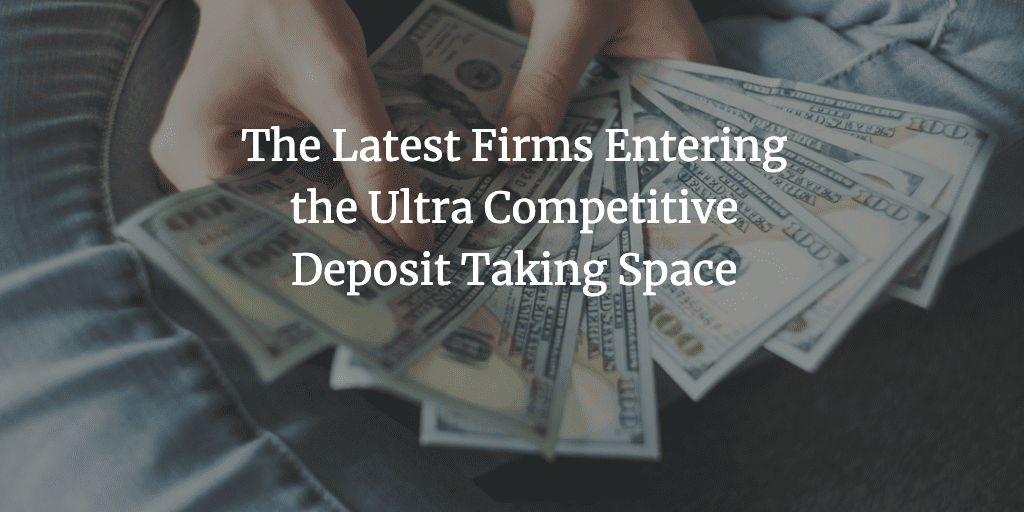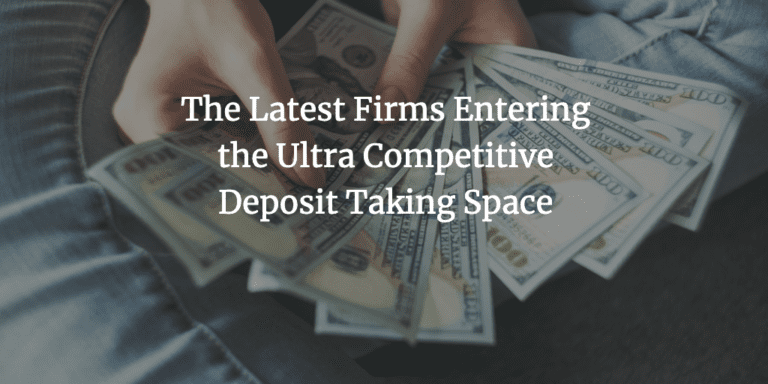
It seems like every week there is a new entrant into the US deposit taking space. Clearly there is an appetite for consumer deposits and banks and fintechs alike are willing to compete for the business. Ultimately, this is good news for the US consumer as never before has there been so many options. The competitiveness leads to both lower (or no) fees and higher yields on banking products. It’s an interesting phenomena as some fees are driven down to zero and there is less differentiation from one product to the next. It’s similar to what we’ve seen in stock trading as the newcomers in the space brought transaction fees to zero and other big firms eventually have had to follow suit. But who will ultimately be the leaders of tomorrow?
The way banks make money today is changing and we’re starting to see a wave of change in consumer banking. Today, most of these deposit products are offering around a 2% APY after falling recently due to the rate cut. Still this beats some of the traditional banks which still get away with paying almost nothing on deposit accounts. It turns out that there is a segment of the population that are set in their ways, but for those willing to make a change these financial firms are collecting deposits online and offer a very quick on-boarding process. In my opinion if you’re a US consumer and earning less than 1% on your savings account you should strongly consider switching to the many reputable product offerings in the market today. Here are some of most recent entrants and unique offerings in this space, all of which offer FDIC insurance.
Santander
The Spanish bank recently announced that they are going to launch a new online deposit platform in the US. Set to launch in the next year, the offering will reportedly pay a higher rate than that of Wall Street banks. The goal for the bank is to access cheaper costs of funding.
Robinhood
Robinhood’s first attempt at a ‘savings account’ fell flat and after ten months they have announced their second attempt. Robinhood’s Cash Managment will pay 2.05% APY as of October 8th. The consumer friendly product has no fees and is currently accepting users via a waitlist. CNBC shares further details.
Personal Capital
Personal Capital didn’t receive a lot of press for their announcement of Personal Capital Cash but I think it’s worth noting due to the fact that they are the first account aggregator to offer a bank account. Personal Capital is a great tool for tracking your net worth and is offering 1.80% APY. For those who leverage their advisory service the rate is currently 1.85%. Given the data they have on their customers, they are in a unique position to advertise this offering for consumers who are currently getting far less interest on deposits.
Credit Karma
It’s interesting to think through Credit Karma’s positioning with their new account. First, they have over 90 million customers that currently use their service so they already have a massive customer base to sell into. Credit Karma aims to optimize the rate their customers receive according to this Fortune article. As interest rates change at banks, Credit Karma will take over moving their customers’ deposits to the best offering. This is still achieved through the customer accessing one account with Credit Karma. If this ends up working as explained it makes Credit Karma a compelling option for those always looking for the highest yielding accounts.
N26
N26 is the first of the challenger banks from Europe to launch in the US. They recently exited beta in August and claim a user can open a bank account through their app in jus five minutes. Their waiting list had 100,000 names and they are getting a couple of thousand sign-ups per week as of late August. While they offer a slick app, no fees and some other unique features they are not attempting to lure customers with the promise of a higher interest rate.
Wealthfront & Betterment
I am lumping these two together because their offerings are largely the same. Wealthfront offers their “Cash Account” while Betterment calls it “Cash Reserve”. Both pay around 2% APY. The interesting thing here is that these companies came at the savings account from a different direction having first starting as a robo-advisor. The result is that they have the benefit of already having customers they can market to instead of having to start from scratch.
SoFi Money
SoFi started their business in the student loan space and have expanded significantly into almost every vertical since. SoFi Money took the approach of offering one account for everything which merges the features of a checking and savings account all into one. The simplicity sets SoFi apart from many of the others. The account pays 1.80% APY. You can learn more about SoFi Money from our review earlier this year.
Green Dot
Green Dot is one of the offers which lead off with some pretty compelling rates. They offer 3% on savings accounts alongside 3% cash back on all online and app purchases when using the debit card. CEO Steve Streit stated that these numbers are sustainable and meant to be permanent. This makes them one of the highest paying accounts in the market today.
Varo
Varo is one of the fintechs in the US which started with banking products. They offer both a checking type account with debit card along with a savings account which pays up to 2.80% if you meet certain requirements. One of their leading features is that customers can access their paychecks up to 2 days early. They also recently introduced overdraft protection. Varo is also unique in that they are applying for a bank charter with the OCC which means they could eventually not be beholden to a partner bank.
Chime
Chime offers similar features to Varo with getting paid early, fee-free overdrafts, but they also offer automatic savings. They also are very much focused on a mobile first user experience though their accounts do not pay interest.
MoneyLion
MoneyLion first launched their checking account in October, 2018. MoneyLion aims to be a full service offering where customers can bank, invest and access credit. They have opted for a membership approach with different tiers though the lowest tier does offer a zero-fee checking account. The Plus account includes a credit builder loan, investing and cash advances while the Instacash offering allows advances up to $250 at 0% APR.
Finn
Despite all of the success in the digital banking space there have been failures. The most notable one was JP Morgan Chase’s Finn that was aimed at millennials. After two years they have shut down the service. This Business Insider article digs into the issues they ran into along he way.
Conclusion
It’s worth emphasizing that this is a list of the new entrants to the space. There are still many compelling offerings from a wide variety of banks such as Goldman Sachs’ popular Marcus account or my favorite, Ally. These larger institutions are part of the reason this sector is receiving so much attention as of late. Going forward we’re likely to see many more entrants, including many of the leading UK challenger banks entering the US. Over the long run it’s going to be interesting to see how these companies differentiate themselves in what seems like a crowded market.


